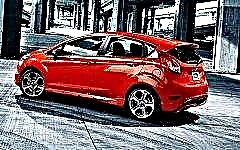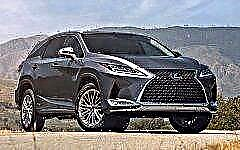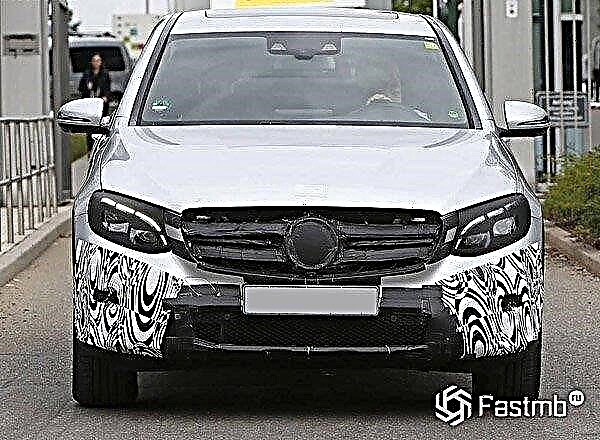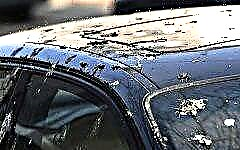

The content of the article:
- The consequences of pollution
- Why varnishes and paints "give in" to bird droppings
- Is there protection
- Removing pollution
- Not just the body!
If bird droppings are not wiped off the car body for a long time, this seemingly harmless speck can easily turn into a major nuisance for the car. And the point here is not at all that it is not aesthetically pleasing to admire the feces of the feathered tribe, and rubbing off is unpleasant. The problem literally lies much deeper: droppings easily destroy the paintwork.
The consequences of pollution

In the event that bird droppings are not soon removed from the car body, it begins to chemically interact with the paint and varnish layer. As a result, the following situations are possible:
- discoloration of paint under droppings;
- dissolution of the film layer;
- swelling of paint;
- the appearance of cracks in the paintwork of the body;
- the formation of bubbles on the paint layer.
All the damage described not only spoil the appearance of the car, but also open a wide straight road to the main enemy of automotive technology - corrosion... The destruction of the paint and varnish layer in itself is not scary, except that it will annoy fans of the ideal appearance of the car. The scary thing is that the unprotected metal of the body is easily destroyed by the environment, and a car with a damaged coating will quickly become not just ugly, but dangerous to operate.
Why varnishes and paints "give in" to bird droppings

The main reason for the forced increased attention of motorists to bird droppings on the car body lies in one unpleasant feature of birds.
The waste product of birds differs significantly from the excrement of other species of living creatures. The excretory system of a bird does not have such an "option" as urination. This means that nitrogenous compounds, which are produced by almost any living organism and which in most animal species are excreted in the form of a solution of urea in urine, are excreted in birds in the form of uric acid. Uric acid makes up a large proportion of avian secretions and appears as a white substance.
Thus, bird droppings are a mixture of chemically aggressive organic acids, which are extremely slightly soluble in water, but at the same time easily corrodes varnishes and paints that cover a car body.
It is precisely because of the poor dissolution in water that it will not work to remove already dried droppings from the machine with a damp cloth. Worse, water does not dissolve the compound, but activates the destructive effect of acid, which is generally not dangerous without moisture.
Also, do not hope that the bird's "hello" will simply dry out in the sun and lose its aggressive qualities: the high temperature only aggravates the problem, activating the rate of flow of corrosive and other destructive processes.
Because hot sun and atmospheric moisture intensify destruction, bird droppings on car bodies pose the greatest problems to owners in hot, humid climates. But this does not mean that in other conditions the problem does not exist: it only develops more slowly, but it still leads to the same result.
Do not forget that birds, to facilitate digestion, throughout their life, swallow small pebbles that help grind food in the stomach. These pebbles are also removed with droppings, and in addition to chemical aggressiveness, excrement is also abrasive.
Is there protection

Unfortunately, acid-resistant protective coatings for the car body do not exist today. However, you can use wax and protective polymer compounds, which for some time can protect against aggressive acidic compounds.
It will not be possible to completely forget about the problem, but nevertheless, the use of these means forms a moisture-repellent film on the surface of the engine body, which prevents the adhesion of contaminants of any nature. This gives the motorist some time to get rid of the pollution without harming the cover.
It is also important to remember that the applied protective wax or polymer layer wears off quickly enough and must be renewed regularly.
In order to reduce the likelihood of getting contaminated, you should not park your car under trees, especially where there are bird nests, and under the wires - a favorite "roost" of pigeons and other urban feathered inhabitants.
If circumstances force you to often park under the trees, it is better to think about purchasing a car cover. It may seem too expensive and impractical, but believe me, dried droppings can cause a car owner much more problems than the cost of purchasing a cover and the need to cover the car with it.
Removing pollution

The main rule for the safety of car coverage is to get rid of bird "surprises" as soon as possible. The main task is to have time to do this before the acid enters into a chemical reaction with the paint under the influence of moisture and the baking sun.
Getting started, there is an important rule to remember:
Poultry droppings are often a breeding ground for pathogenic bacteria and can cause infection with infectious diseases. Therefore, it is necessary to remove it from the car only with gloves. It is better if the gloves are disposable - after finishing work, they can simply be packed in a bag and thrown away, and hands should be thoroughly washed or wiped with a disinfectant.
There are several tools for removing bird droppings. Which one to choose depends on the degree of pollution and its age.
Soft fabric
If the droppings are quite fresh, they can be carefully removed with a damp soft cloth. At the same time, do not forget that the composition of the pollution is abrasive, which means that if you rub, you can easily leave scratches on the paint.
Carefully scoop up the dirt with a rag and remove from the body. The remaining fragments must be washed off with water and the surface must be gently wiped clean.
Plain clean water

It is used if the droppings have already dried, but the pollution has not been more than a few days, and the acid has not had time to react with the surface.
You need to take a wet gauze rolled up 6-8 times or a piece of soft rags, put it on the dirt and pour water on top. The fabric retains water, preventing it from spreading over the surface of the body. At the same time, moisture will penetrate the dirt and soften it without damaging the paint.
When the droppings are softened, it must be carefully removed with the same rag. In order not to scratch the surface, the remaining abrasive particles can be removed with a special cleaning clay, which is used for cleaning varnished surfaces.
Also simple soda gives good results with fresh droppings: The carbon dioxide contained in this drink carbonizes the acidic compounds, and they break down, becoming harmless to the paint layer.
Alkaline compounds
Acid is "not friendly" with alkali, therefore, to remove droppings, you can use ordinary baking soda or household soda, dissolving it in clean water. The resulting solution should be used in the same way as ordinary water in paragraph 1. You may have to wait about half an hour until the composition softens the contamination.
Any alkaline cleanser will also work.
Remember that the baking soda solution is also abrasive, so, again, don't rub the stain.
Mix of water with isopropyl alcohol
IPA (isopropyl alcohol) is mixed with distilled water in equal proportions. In relation to acid, alcohol works as an adsorbent, and this property is enhanced in combination with water. After applying the composition to the contamination, you should wait two to three minutes until the solution reacts with the droppings, and then rinse everything off with clean water.
In addition to making your own solution, you can use any isopropyl alcohol-based household cleaners.
Universal multipurpose compound WD-40
The agent is sprayed onto the dirt, soaking it well. After 5-10 minutes, you can remove the droppings with a disposable napkin or a piece of rag. The manufacturers of this universal cleaner indicate that one of the ways to use the product is to clean the car paintwork from bird droppings. At the same time, the composition itself is neutral to the paint layer, does not destroy it.
Dimexide
A folk remedy for bird droppings is also called ordinary dimexide is a drug that can be purchased at pharmacies... Being a strong alkaline compound, it also copes well with this kind of dirt. But in the case of its application, it should be remembered that Dimexide itself is aggressive and can spoil the varnish film. Therefore, it should be applied to the stain in a small amount and removed quickly, without overexposing.
Coca Cola
This amazing drink is generally capable of a lot.: it's not for nothing that housewives got the hang of using it to remove old dirt. In the case of droppings, Coca-Cola also does not fail, although it probably will not be as effective as special means for cleaning the body. At the same time, it has one advantage over the same Dimexidum - it is not so dangerous for the lacquer layer of the body.
Not just the body!

If the birds, by some accident, spared the body of the car, but at the same time stained the windshield, you should also take care of the cleaning issue as soon as possible. Litter is equally aggressive to glass surfaces; it must be removed from the glass as quickly as from the body.
If, after the bird droppings are removed from the car body, small scratches remain on the surface, it is worth abrasive polishing the surface. The main thing to remember, having received a “bird's greetings” on the hood, is not to delay cleaning. The later you get down to business, the more difficult the process will be!











